Experiments of Main Parameters Affecting the Erosive Behavior of Self-Excited Oscillating Abrasive Water Jets: Length of Self-Oscillation Chamber, Jet Pressure, Abrasive Fluid Velocity, and Abrasive Grain Size
Abstract
:1. Introduction
2. Processing Principle
3. Simulation Model
3.1. Fluid Control Modeling
3.2. Erosion Model
3.3. Wall Bounce Function
3.4. Boundary Conditions
4. Simulation of Erosion Results
4.1. Particle Size
4.2. Particle Mass Flow Rate
4.3. Inlet Velocity
5. Experimental Conditions and Methodology
5.1. Experimental Setup
5.2. Experimental Materials
5.3. Experiment
6. Results and Discussion
6.1. Self-Oscillation Chamber Length
6.2. Jet Pressure
6.3. Abrasive Flow
6.4. Abrasive Grain Size
7. Conclusions
8. Outlook
Author Contributions
Funding
Institutional Review Board Statement
Informed Consent Statement
Data Availability Statement
Conflicts of Interest
List of Symbols
| Density | |
| Instantaneous velocity | |
| Three-dimensional coordinate direction | |
| Modified subgrid scale tensor | |
| Erosion rate | |
| Number of particles | |
| Particle mass flow | |
| Particle size function | |
| Impact angle function | |
| Processing wall area | |
| D/d | Lower nozzle diameter/upper nozzle diameter |
| H/d | Chamber diameter/upper nozzle diameter |
| L | Length of cavity |
| The angle of the collision wall | |
| V | Inlet velocity |
| P | Jet pressure |
| D | Abrasive particle size |
| H | Target distance |
| W | Abrasive concentration |
| M | Abrasive flow |
References
- Zhang, G.; Li, Y.; Zheng, S.; Liang, Y.; Wang, Q.; Li, S.; Chen, L. High performance SiC fiber-reinforced celsian matrix composites with BN/C/SiNx/C interface. J. Eur. Ceram. Soc. 2024, 44, 4482–4492. [Google Scholar] [CrossRef]
- Katoh, Y.; Snead, L.L.; Henager, C.H., Jr.; Nozawa, T.; Hinoki, T.; Ivekovic, A.; Novak, S.; de Vicente, S.M.G. Current status and recent research achievements in SiC/SiC composites. J. Nucl. Mater. 2014, 455, 387–397. [Google Scholar] [CrossRef]
- Qu, S.; Yao, P.; Gong, Y.; Yang, Y.; Chu, D.; Zhu, Q. Modelling and grinding characteristics of unidirectional C-SiCs. Ceram. Int. 2022, 48, 8314–8324. [Google Scholar] [CrossRef]
- Ma, G.; Li, S.; Liu, F.; Zhang, C.; Jia, Z.; Yin, X. A Review on Precision Polishing Technology of Single-Crystal SiC. Crystals 2022, 12, 101. [Google Scholar] [CrossRef]
- Zhou, K.; Xu, J.; Xiao, G.; Huang, Y. A novel low-damage and low-abrasive wear processing method of Cf/SiC ceramic matrix composites: Laser-induced ablation-assisted grinding. J. Mater. Process. Technol. 2022, 302, 117503. [Google Scholar] [CrossRef]
- Hou, R.; Huang, C.; Zhu, H. Experimental study on pulsation behavior of the ultrasonic vibration-assisted abrasive waterjet. Int. J. Adv. Manuf. Technol. 2017, 91, 3851–3859. [Google Scholar] [CrossRef]
- Yong, W.; Hongtao, Z.; Chuanzhen, H.; Jun, W.; Peng, Y. A study on ultrasonic torsional vibration-assisted abrasive waterjet polishing of ceramic materials. Adv. Mat. Res. 2015, 1136, 400–405. [Google Scholar] [CrossRef]
- Zhang, Y.; Liu, D.; Zhang, W.; Zhu, H.; Huang, C. Mechanism of Cf/SiC hole making with high shape precision using abrasive waterjet based on response surface method. Ceram. Int. 2023, 49, 4129–4140. [Google Scholar] [CrossRef]
- Zhang, H.; Tao, B.; Deng, Q.; Zhang, C.; Lyu, B.; Nguyen, D.-N. Research on Abrasive Water Jet Polishing of Silicon Carbide Based on Fluid Self-Excited Oscillation Pulse Characteristics. Micromachines 2023, 14, 852. [Google Scholar] [CrossRef]
- Thakur, P.M.; Raut, D.N. Sensor-based process control of abrasive waterjet machining: A review. Int. J. Mach. Mach. Mater. 2023, 25, 266–292. [Google Scholar] [CrossRef]
- Tie, G.; Zhang, Z.; Wang, B.; Song, C.; Shi, F.; Zhang, W.; Si, H. Optimization of the Morphology of the Removal Function for Rotating Abrasive Water Jet Polishing. Micromachines 2023, 14, 1931. [Google Scholar] [CrossRef] [PubMed]
- Wang, R.J.; Wang, C.Y. Effect of Micro Abrasive Slurry Jet Polishing on Properties of Coated Cemented Carbide Tools. Chin. J. Mech. Eng. 2023, 36, 132. [Google Scholar] [CrossRef]
- Ma, Y.; Zhao, W.; Zhang, H.; Ma, L.; Fan, C.; Zhang, X.; Li, D. A new method for laser grooving titanium alloy with the assist of a hybrid of gas jet and waterjet. J. Mater. Process. Technol. 2023, 315, 117906. [Google Scholar] [CrossRef]
- Cuha, D.; Hatala, M. Effect of a modified impact angle of an ultrasonically generated pulsating water jet on aluminum alloy erosion using upward and downward stair trajectory. Wear 2022, 500–501, 204369. [Google Scholar] [CrossRef]
- Zhu, H.; Jiang, Z.; Han, J.; Saetang, V.; Xu, K.; Liu, Y.; Zhang, Z.; Huang, S.; Zhou, J. Fabrication of oxide-free dimple structure on germanium via electrochemical jet machining enhanced by opposing laser irradiation. J. Manuf. Process. 2023, 85, 623–635. [Google Scholar] [CrossRef]
- He, X.; Song, M.; Du, Y.; Shi, Y.; Johnson, B.A.; Ehmann, K.F.; Chung, Y.-W.; Wang, Q.J. Surface hardening of metals at room temperature by nanoparticle-laden cavitating waterjets. J. Mater. Process. Technol. 2020, 275, 116316. [Google Scholar] [CrossRef]
- Steeves, A.J.; Lomboni, D.J.; Vijay, M.; Tieu, A.; Variola, F. Direct cueing by pulsed-waterjet treated titanium on fibroblast, osteoblastic and human stem cells for prospective use in dental implants. Mater. Lett. 2021, 290, 129437. [Google Scholar] [CrossRef]
- Zhang, M.; Li, D.; Kang, Y.; Huang, M.; Yuan, M. Experimental study on the rock erosion performance of a pulsed abrasive supercritical CO2 jet. J. Pet. Sci. Eng. 2021, 201, 108489. [Google Scholar] [CrossRef]
- Xiang, M.; Wang, X.; Li, D.; Chen, H.; Qian, L. Effects of Helmholtz upper nozzle outlet structure on jet oscillation characteristics. J. Vib. Shock 2020, 39, 74–80. [Google Scholar]
- Liu, Y.; Wang, C.; Wei, J.; Chen, C. Effect of nozzle pressure ratio on pulsation frequency of air jets used in hole drilling. J. Pet. Sci. Eng. 2021, 196, 107399. [Google Scholar] [CrossRef]
- Deng, Q.; Wang, Y.; Yuan, J.; Lyu, B.; Zhao, T.; Wang, X. Simulations and Experiments on Abrasive Water Jet Machining Based on Fluid Self-excitation. China Mech. Eng. 2022, 33, 279–289. [Google Scholar]
- Zhang, C.; Zhang, Y.; Zhang, F.; Luan, D. Development of new entrainment abrasive waterjet system. J. Mech. Eng. 2015, 51, 205–212. [Google Scholar] [CrossRef]
- Zhu, H.T.; Huang, C.Z.; Wang, J.; Feng, Y.X.; Hou, R.G. Theoretical analysis on the machining mechanism in ultrasonic vibration abrasive waterjet. Adv. Mach. Manuf. Technol. 2006, 315–316, 127–130. [Google Scholar] [CrossRef]
- Deng, Q.; Dong, R.; Sun, L.; Zhang, C.; Lyu, B.; Wang, X.; Yuan, J. Edge passivation of carbide cutting tool based on abrasive water jet of fluid self-excited oscillating characteristics. Int. J. Adv. Manuf. Technol. 2023, 129, 2661–2676. [Google Scholar] [CrossRef]
- Li, Z.; Wei, X.; Yi, Z.; Ma, Z.; Yu, Y.; Wang, W. Numerical analysis of gas-liquid-solid erosion characteristics of the oil and gas multiphase pump. Eng. Fail. Anal. 2024, 157, 107889. [Google Scholar] [CrossRef]
- Melentiev, R.; Fang, f. Prediction of crater depth, surface roughness and erosion rate during abrasive jet machining of glass. Wear 2021, 468–469, 203596. [Google Scholar] [CrossRef]
- Beck, A.; Ortwein, P.; Kopper, P.; Krais, N.; Kempf, D.; Koch, C. Towards high-fidelity erosion prediction: On time-accurate particle tracking in turbomachinery. Int. J. Heat Fluid Flow 2019, 79, 108457. [Google Scholar] [CrossRef]

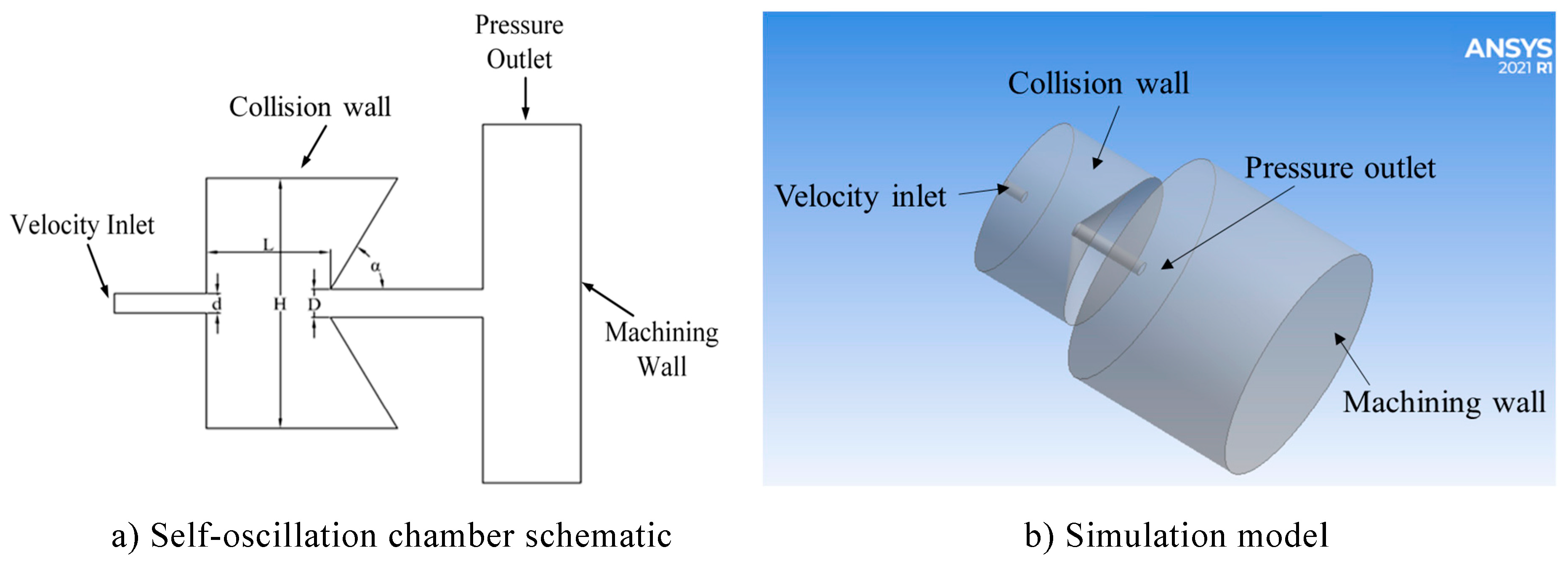

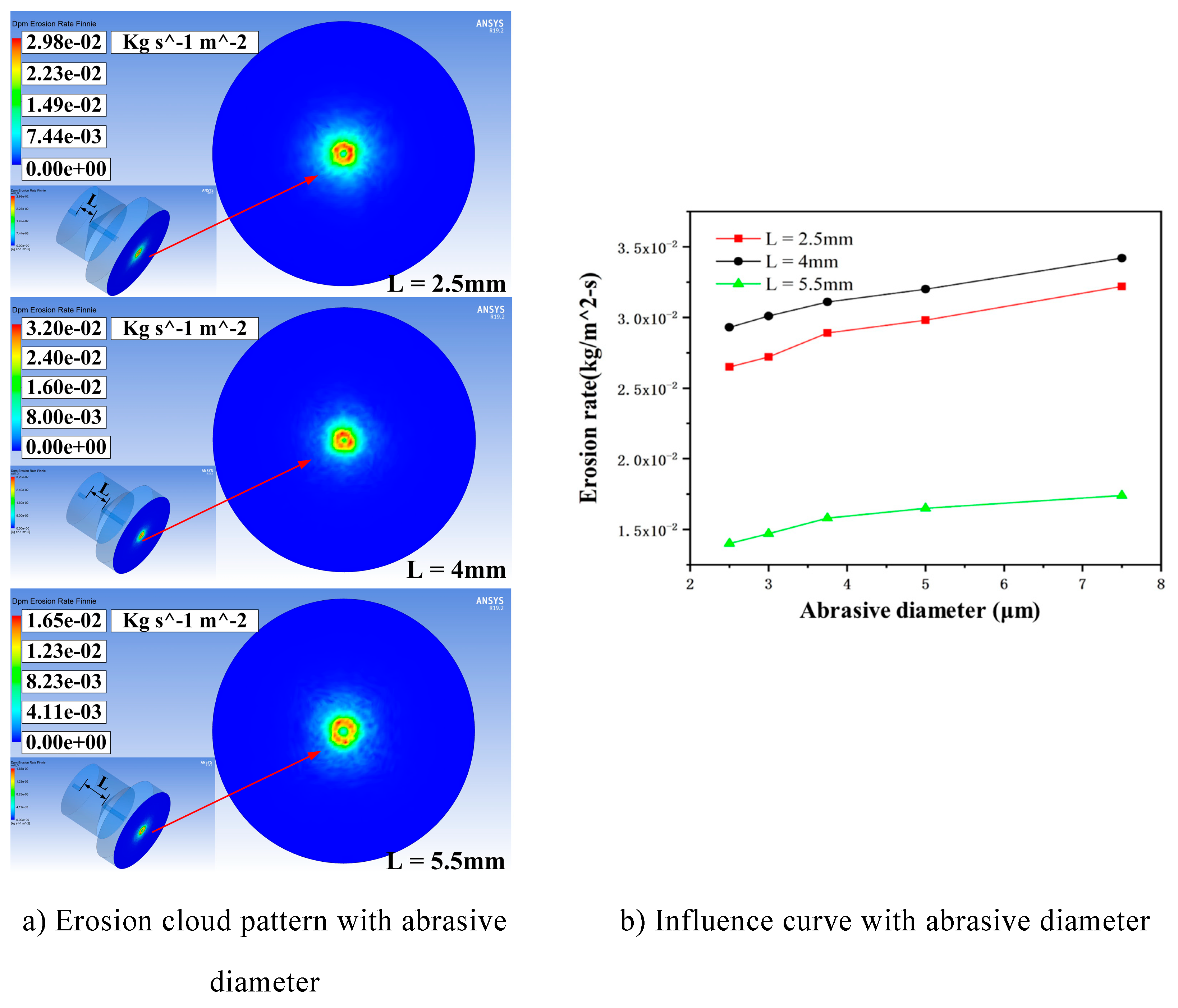
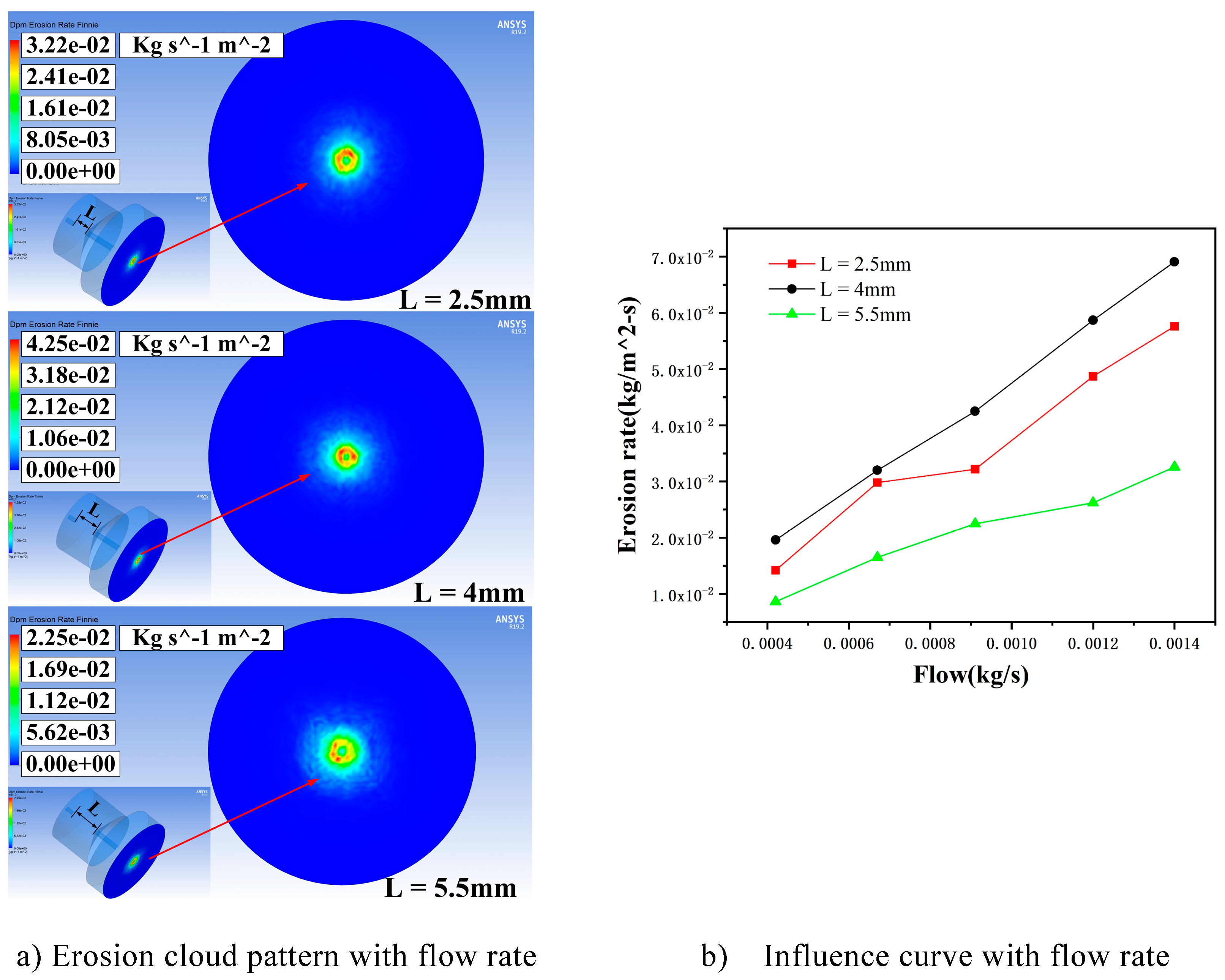

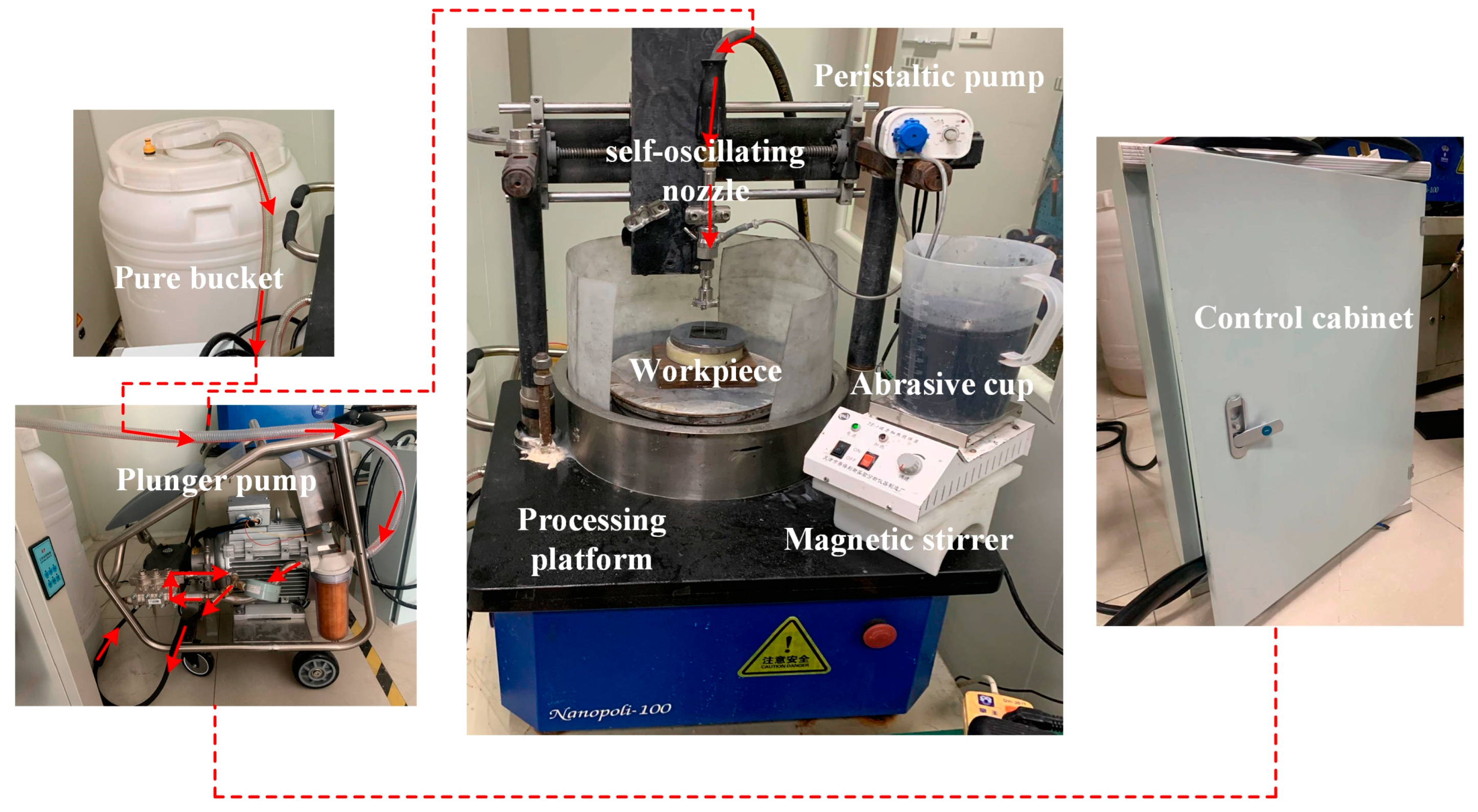
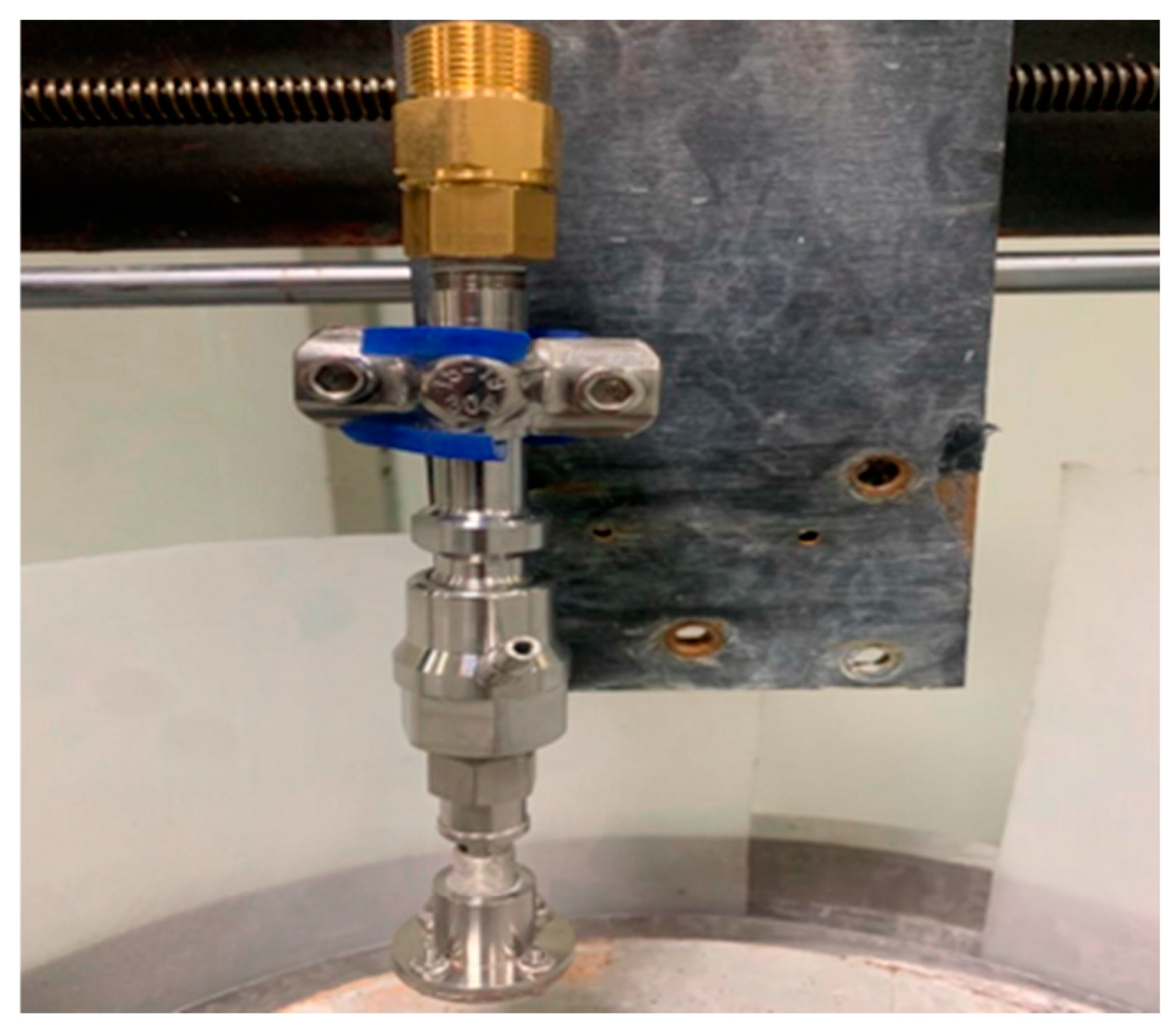
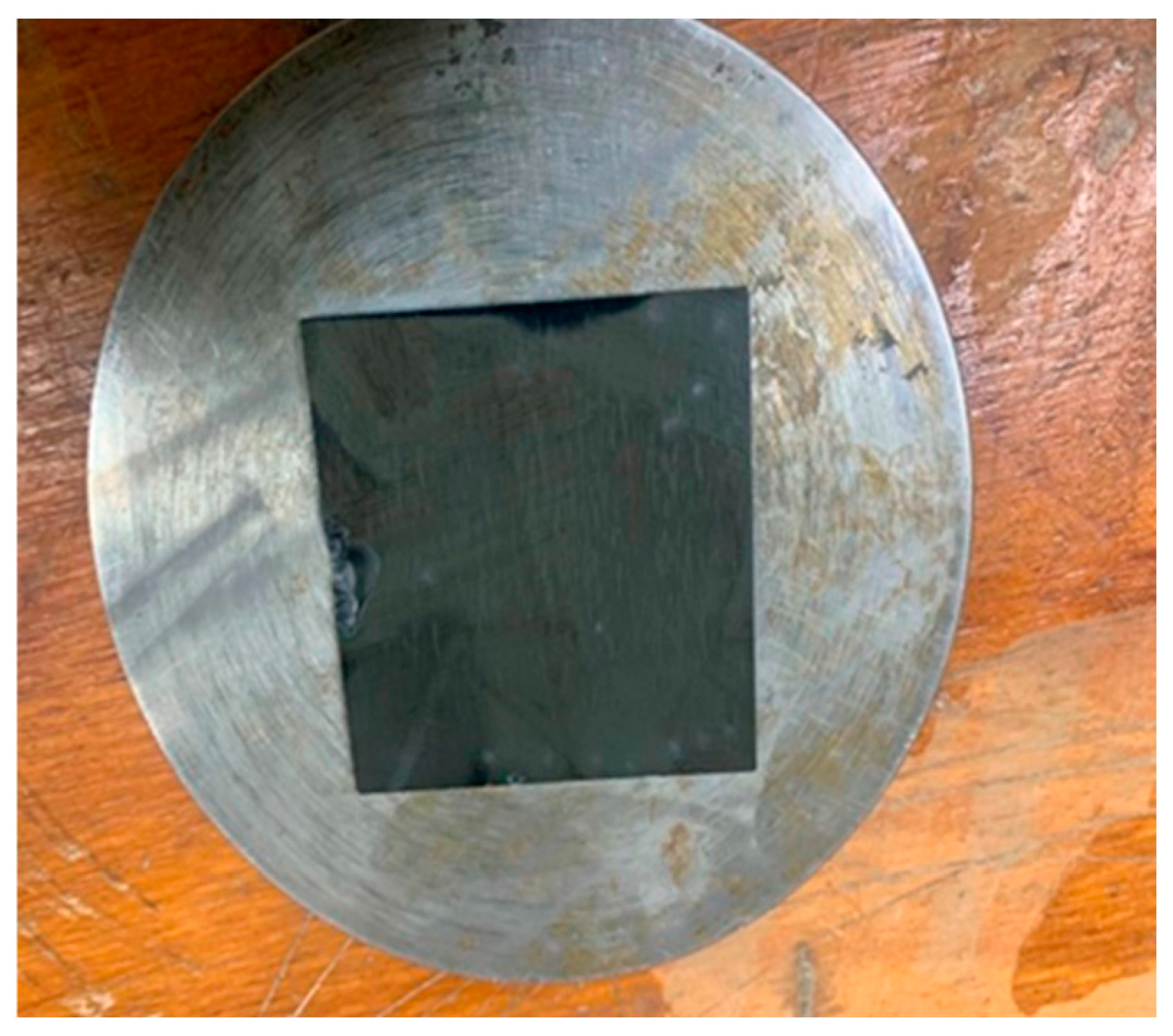
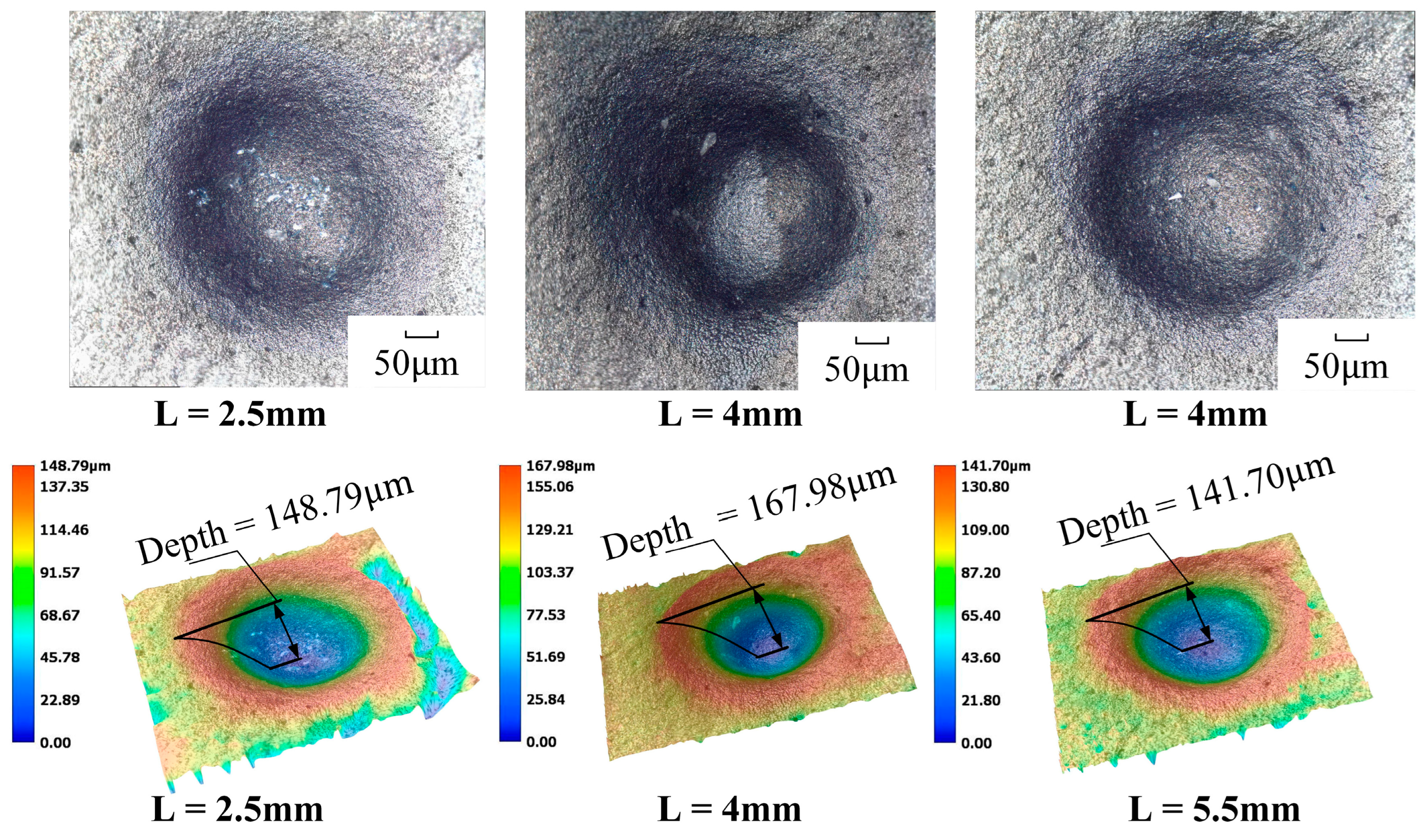
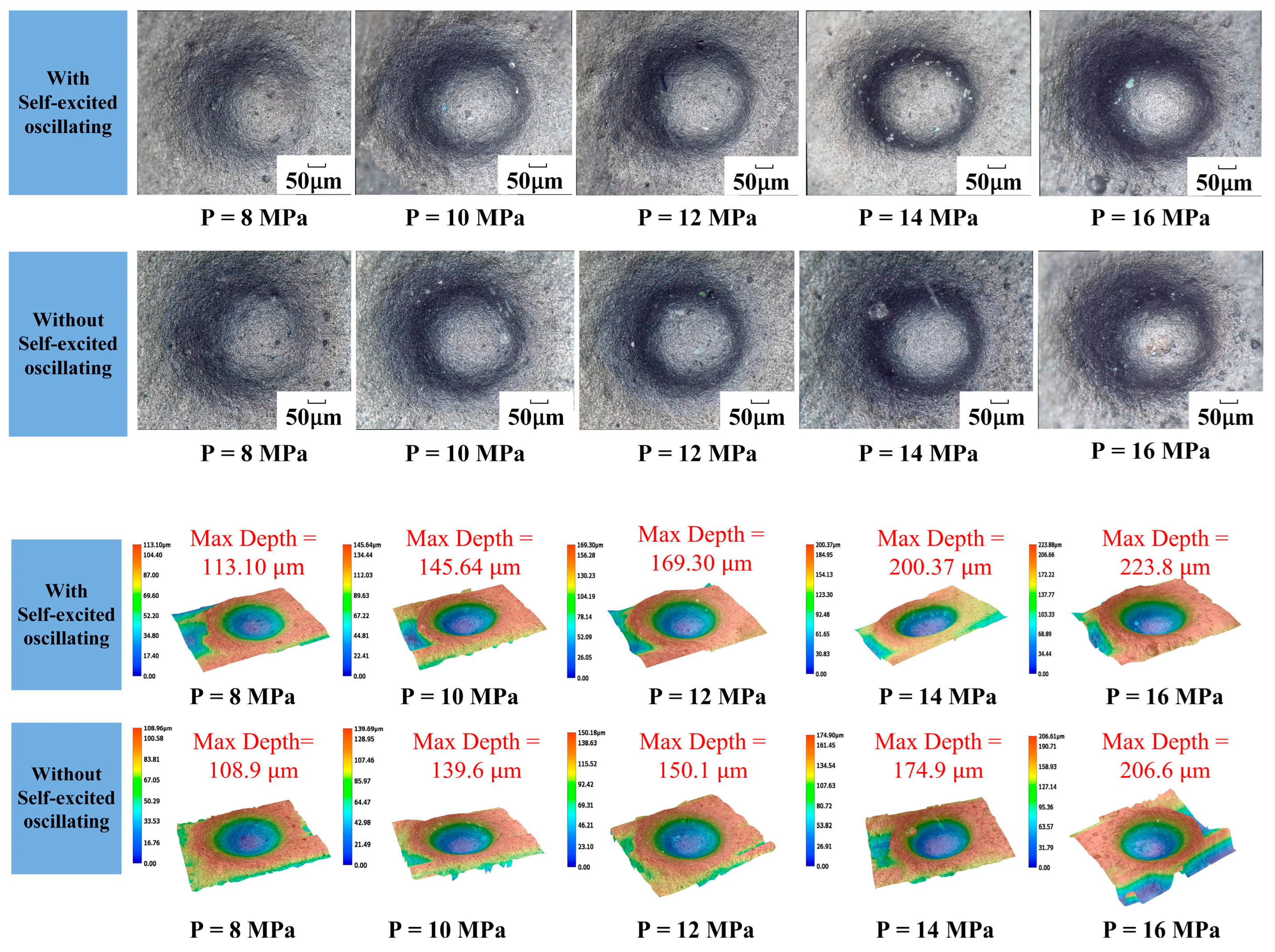
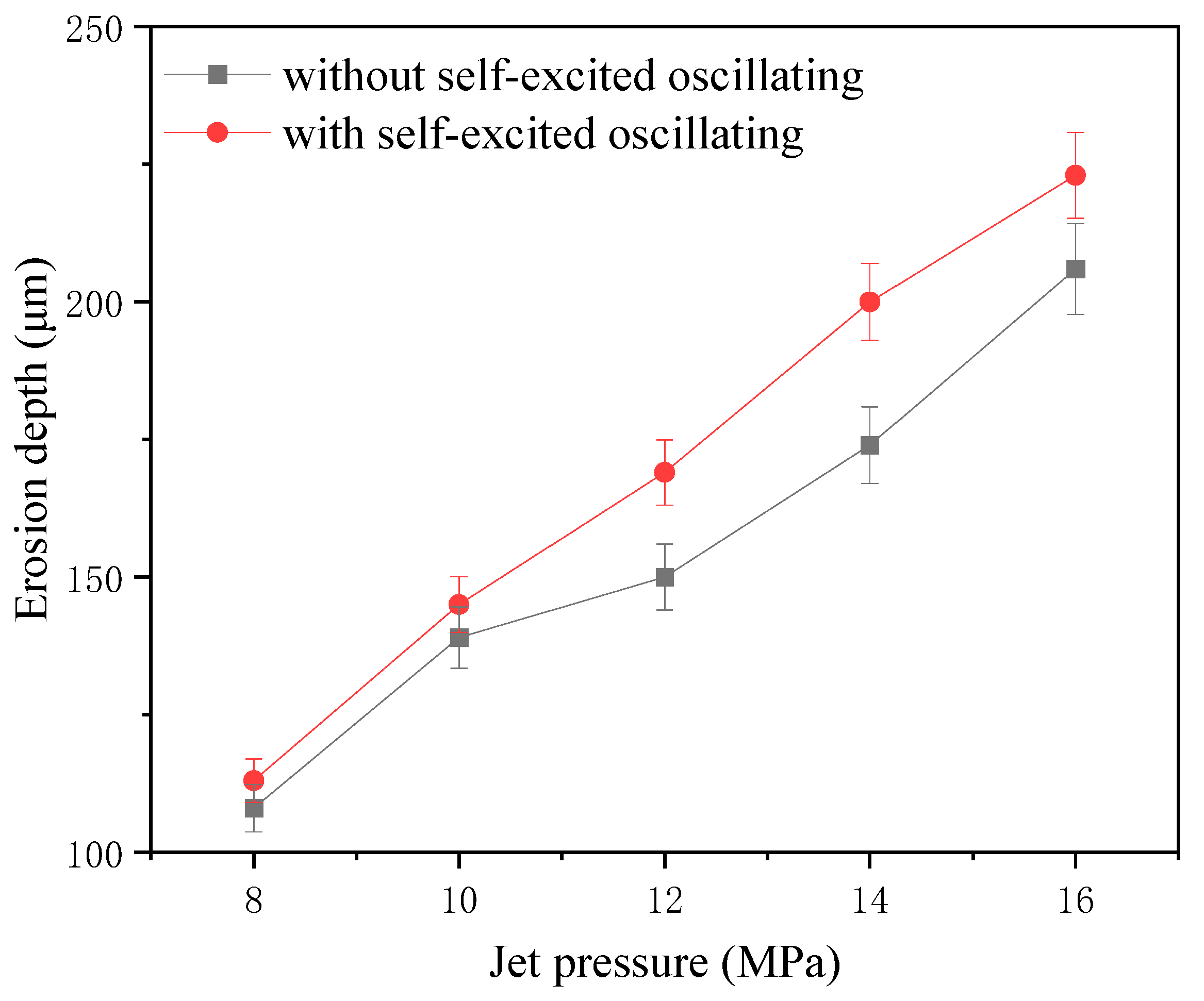

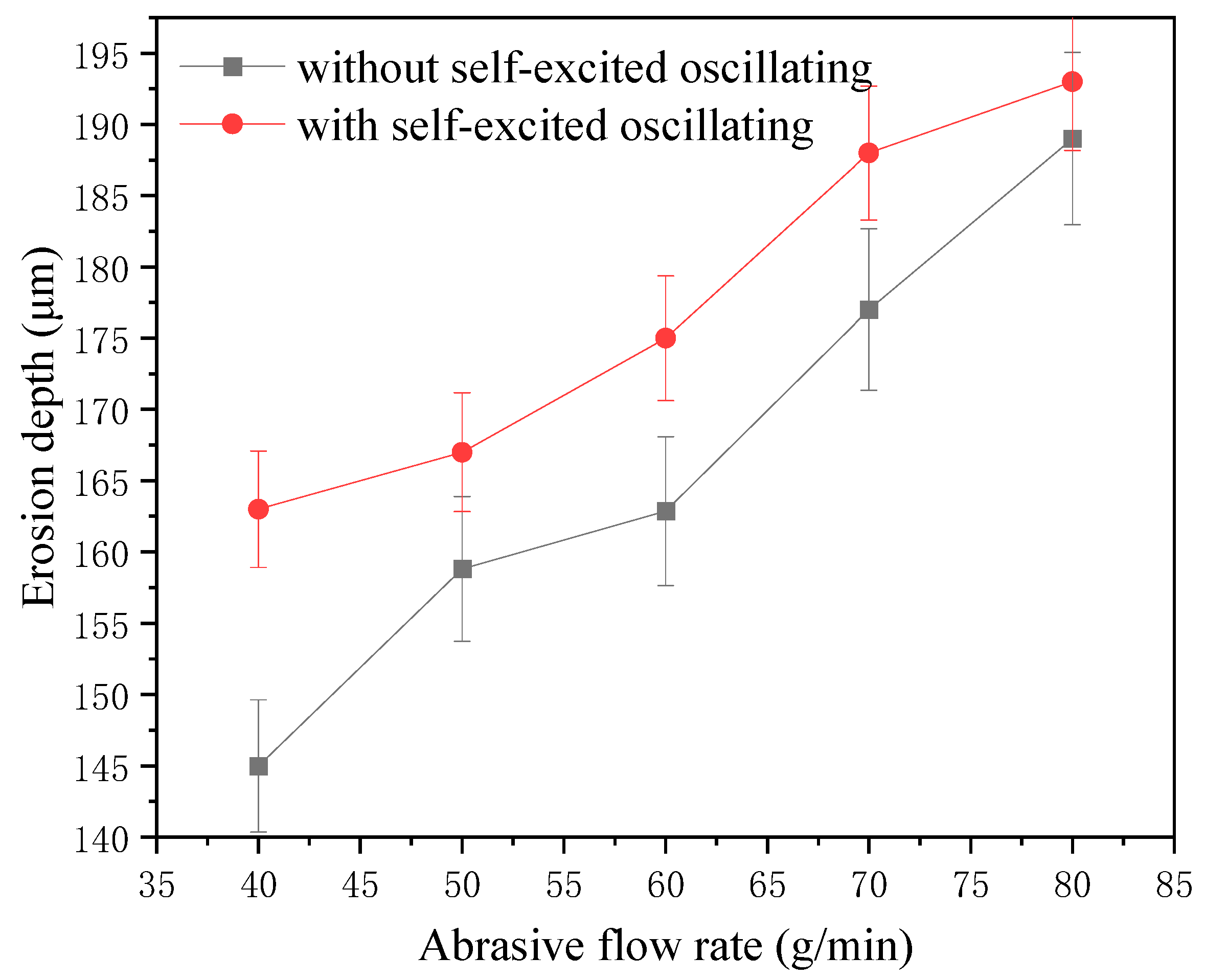
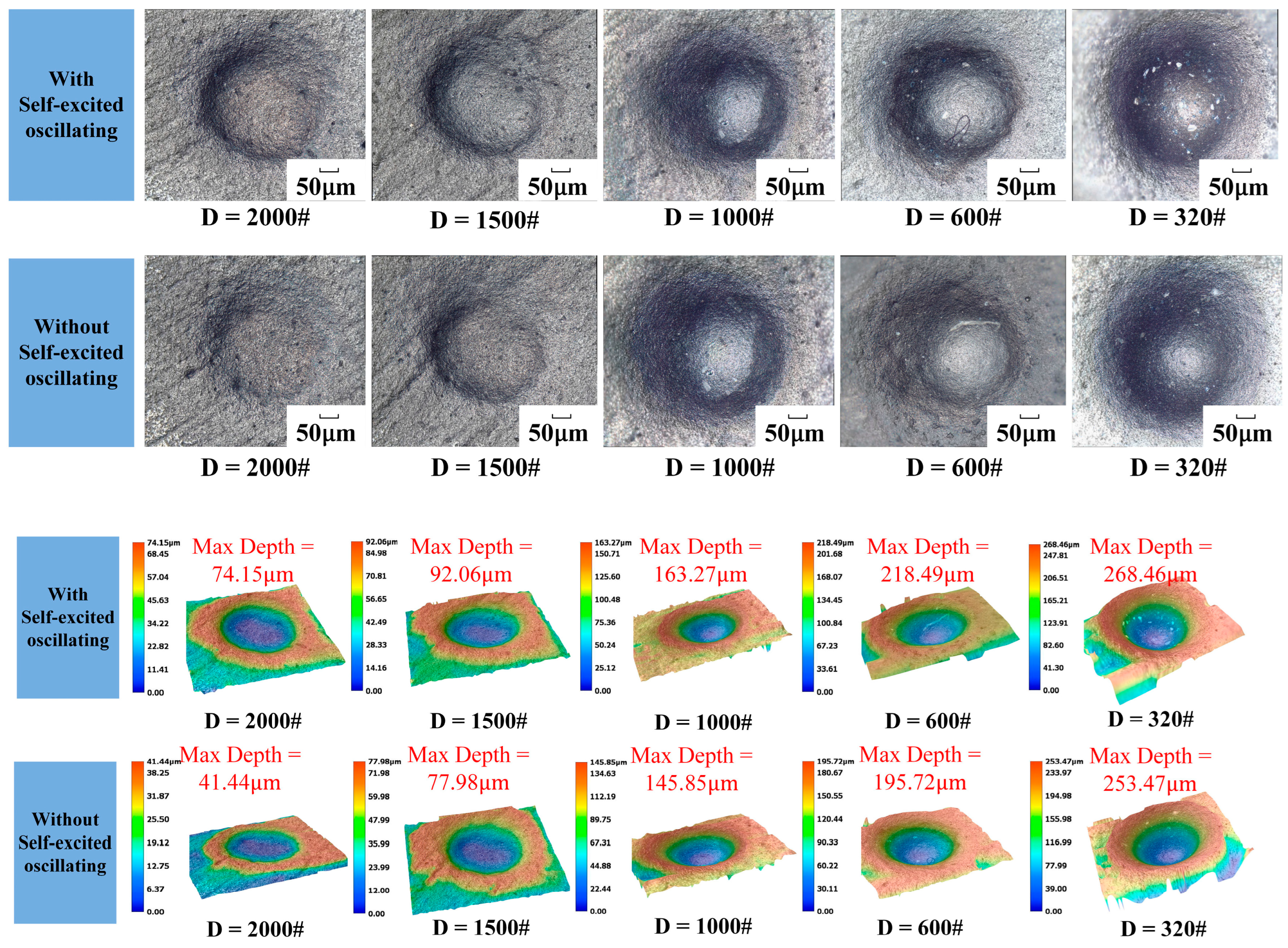
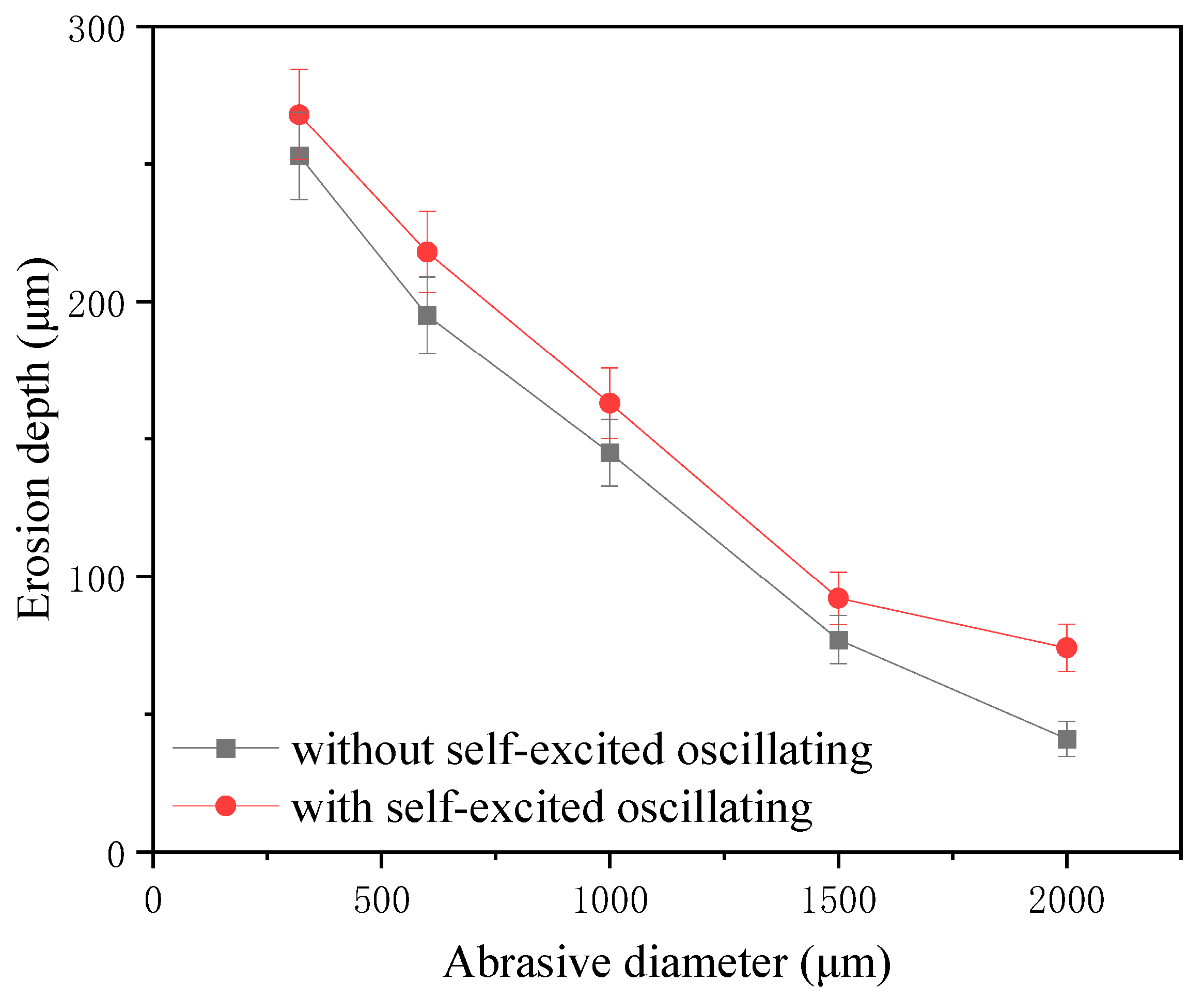
| Coefficients | ||||
|---|---|---|---|---|
| 0.993 | 1.76 | 1.54 | −0.49 | |
| 0.998 | −1.66 | 2.11 | −0.67 |
| D/d | 1.32 |
| H/d | 5.92 |
| L (mm) | 2.5, 4, 5.5 |
| () | 60 |
| d (mm) | 0.76 |
| Parameters | Values |
|---|---|
| Water density/ | 998 |
| Inlet velocity V/ Particle density/ Particle mass flow rate/ | 125~145 3515 0.00042~0.0012 |
| Particle size/ Gravitational acceleration/ | 2.5~6.5 9.8 |
| Hydraulic diameter/ | 55 |
| Jet Pressure P/MPa | Abrasive Particle Size D(#) | Target Distance H/mm | /(°) | Abrasive Concentration W/(wt%) | Abrasive Flow M/(mL/min) |
|---|---|---|---|---|---|
| 8, 10, 12, 14, 16 | 320~2000 SiC | 10 | 90 | 5 | 40, 50, 60, 70, 80 |
Disclaimer/Publisher’s Note: The statements, opinions and data contained in all publications are solely those of the individual author(s) and contributor(s) and not of MDPI and/or the editor(s). MDPI and/or the editor(s) disclaim responsibility for any injury to people or property resulting from any ideas, methods, instructions or products referred to in the content. |
© 2024 by the authors. Licensee MDPI, Basel, Switzerland. This article is an open access article distributed under the terms and conditions of the Creative Commons Attribution (CC BY) license (https://creativecommons.org/licenses/by/4.0/).
Share and Cite
Tao, B.; Zhang, C.; Deng, Q.; Wang, Q.; Zhang, H.; Sun, L. Experiments of Main Parameters Affecting the Erosive Behavior of Self-Excited Oscillating Abrasive Water Jets: Length of Self-Oscillation Chamber, Jet Pressure, Abrasive Fluid Velocity, and Abrasive Grain Size. Materials 2024, 17, 3449. https://doi.org/10.3390/ma17143449
Tao B, Zhang C, Deng Q, Wang Q, Zhang H, Sun L. Experiments of Main Parameters Affecting the Erosive Behavior of Self-Excited Oscillating Abrasive Water Jets: Length of Self-Oscillation Chamber, Jet Pressure, Abrasive Fluid Velocity, and Abrasive Grain Size. Materials. 2024; 17(14):3449. https://doi.org/10.3390/ma17143449
Chicago/Turabian StyleTao, Baochun, Chengqi Zhang, Qianfa Deng, Qiming Wang, Hong Zhang, and Lizhi Sun. 2024. "Experiments of Main Parameters Affecting the Erosive Behavior of Self-Excited Oscillating Abrasive Water Jets: Length of Self-Oscillation Chamber, Jet Pressure, Abrasive Fluid Velocity, and Abrasive Grain Size" Materials 17, no. 14: 3449. https://doi.org/10.3390/ma17143449





